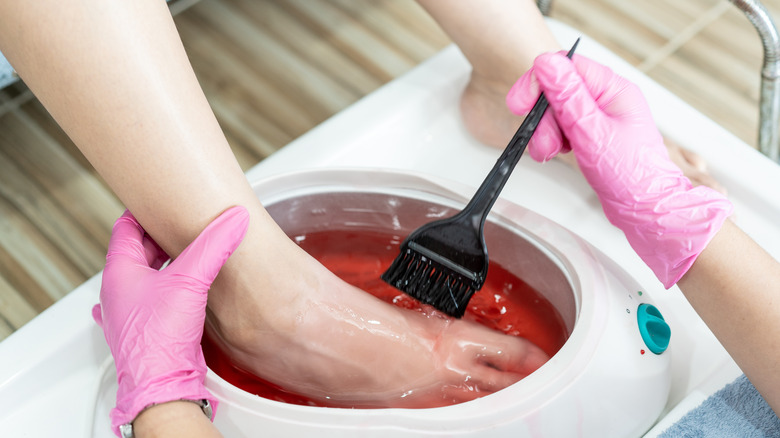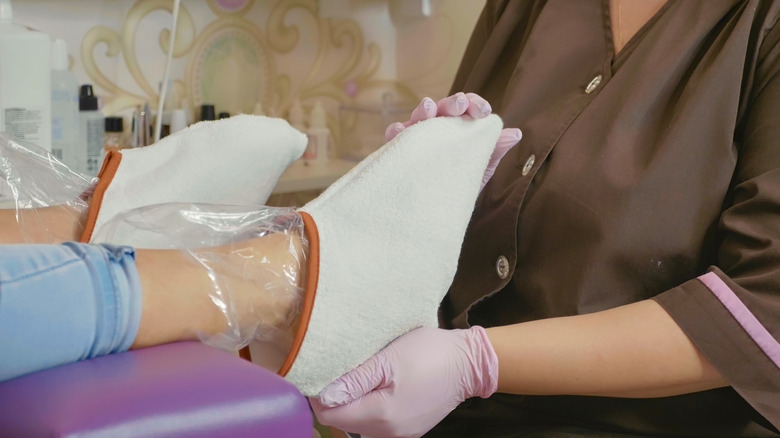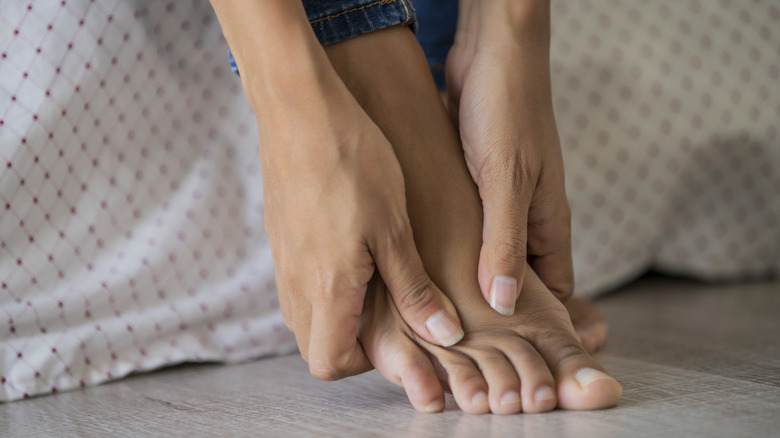Here's What To Know About Paraffin Wax Pedicures
We may receive a commission on purchases made from links.
When you visit the nail salon or spa, you may have seen other customers with their feet dipped in hot wax during a pedicure. This is called paraffin wax, and it's used to give the skin some added moisture and softness as part of a pedicure treatment. Paraffin wax is comprised of hydrocarbons, in the same category as petroleum jelly and mineral oil. It's commonly added to products like cosmetics, moisturizers, and candles
This wax is used in many salons and spas to give clients added moisture to their skin. It can even act as a pain management treatment, too. When life gets super busy, treating and preventing cracked heels is usually an afterthought. But it never hurts to give your feet some extra love and care, especially if you're on them for most of your days. When done on a regular basis, it can be a great way for you to take care of your feet.
What to expect during a paraffin wax treatment
A paraffin wax service is typically done at the beginning of your regular pedicure after the nail technician soaks and exfoliates your feet. Depending on the salon you visit, your feet will either be dipped directly the heated wax, or the technician will paint it on with a brush. After your feet are completely coated in wax, a plastic covering or glove is placed over each foot to help it fully soak up the wax's moisture. Once the wax cools down and hardens, the technician peels it off and reveals your smooth, hydrated feet ready for the polish.
The cost of a paraffin wax service depends on your region and the salon or spa you're visiting. Typically, it comes at an additional cost to your overall pedicure, ranging from $15 to $25, with some salons charging up to $40 for the service.
You can also attempt your own paraffin wax treatment at home. Be cautious when heating up the wax and follow the specific instructions that come with your wax bath kit. Experts at Healthline recommend heating your wax to no higher than 125 degrees Fahrenheit.
Benefits of paraffin wax
Paraffin wax is considered an occlusive moisturizer, meaning it forms a barrier around the skin to help replenish moisture. After a wax treatment, the skin will feel silky-smooth and hydrated, which is especially helpful during colder months when the skin is prone to dryness and cracking. In one 2021 study, paraffin wax therapy was shown to minimize the severity of eczema.
Because heat is involved during application, paraffin wax therapy could provide pain relief for some. In a 2012 study, researchers evaluated the effects paraffin wax therapy had on participants with osteoarthritis. After several weeks of use, participants reported the wax significantly helped to reduce pain in their hands, with researchers concluding it beneficial for therapeutic purposes. Additionally, a 2013 study tested the efficacy of paraffin wax for joint mobility issues, and participants saw improvements in pain and mobilization.
Speaking to LA Times, podiatrist Dr. Ali Sadrieh elaborated on why this works. "Paraffin sends deep heat to the joints, increases blood flow and washes out a lot of the noxious, inflamed sections of the joint, making joints feel better," they told the publication. In other words, not only can the wax leave your skin soft and refreshed, it may also give you some needed pain relief and relaxation.
Warnings and side effects
Paraffin wax is generally safe to use, but it's not always recommended for those with sensitive skin or anyone prone to heat rash. The high heat used during application, as well as the chemical makeup of the wax may cause irritation. During a salon or spa treatment, don't be afraid to make your technician aware of any concerns you have regarding paraffin wax.
According to experts at Healthline, paraffin wax is not recommended for people with poor circulation, hand or foot numbness, diabetes, or open wounds or rashes. If you're concerned about a rash or breakout on your feet, see a podiatrist or dermatologist who can help you resolve the issue.
Other experts also advise being mindful of cleanliness when opting for a paraffin pedicure. Speaking to LA Times, podiatrist Dr. Ali Sadrieh said to be wary of places that use communal wax tubs without a plastic lining, and instead look for places that use individual bags for their treatments if you want to prevent germs from spreading.



